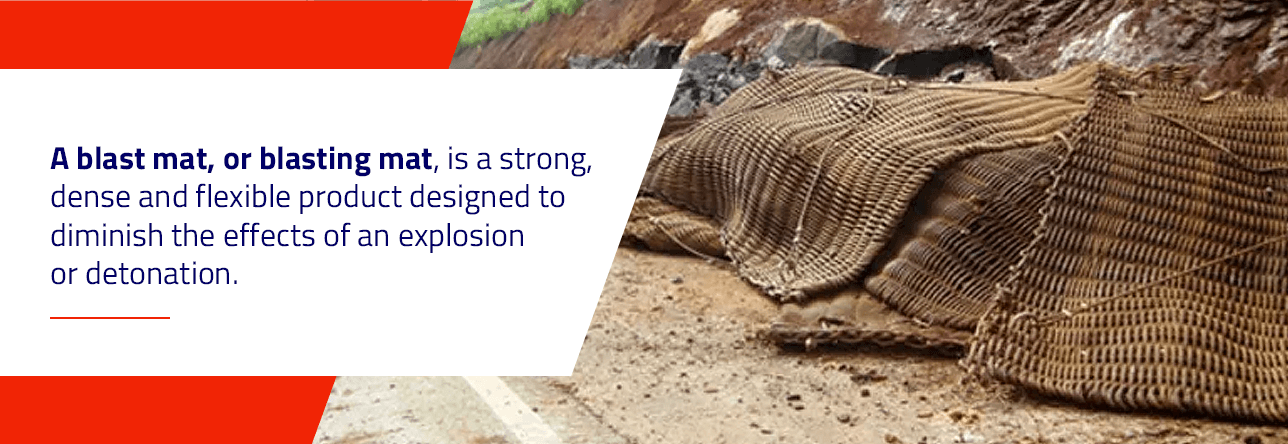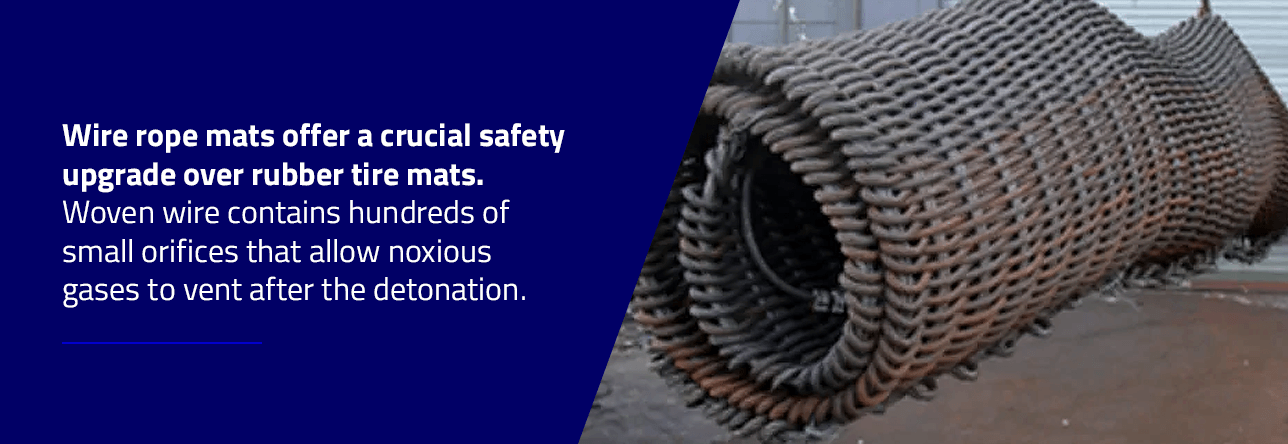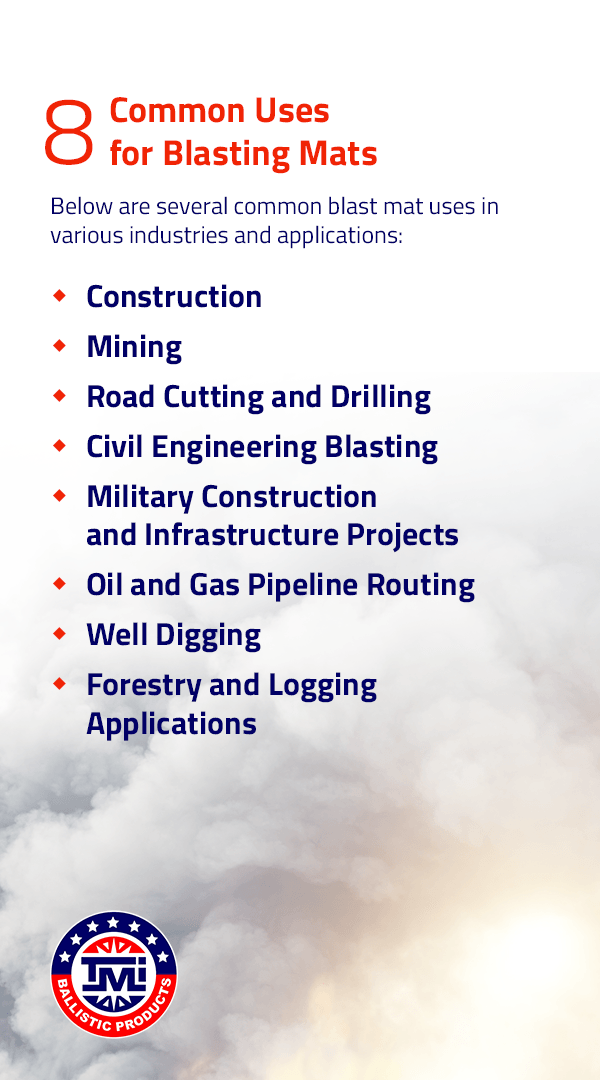
If you work in an industry where explosions are common hazards, you need dependable strategies to ensure safety around explosives or during planned detonations. Between 2015 and 2019, workplace fires and explosions caused 88 to 123 fatalities every year in the U.S. and contributed to many more injuries and damage losses.
Perhaps you need reliable ways to protect personnel and bystanders during a controlled mining or construction blast. You might need trusted methods for protecting military personnel in explosives detonation scenarios. No matter your industry, blast mats offer an ideal solution for blast protection. They are economical, reliable and easy to adapt to a wide variety of projects, topographies and applications.

What Is a Blast Mat?
A blast mat, or blasting mat, is a strong, dense and flexible product designed to diminish the effects of an explosion or detonation. These mats are often useful in applications that involve rock blasting because of their ability to minimize flying debris and prevent damage and injuries. They also control flying dust to minimize mess and reduce potential respiratory risks to nearby personnel and bystanders.
In industries such as mining and construction, some flying debris is inevitable with explosions. Typically, companies try to limit the flying dust and debris as much as possible. Some forms of flying debris pose particular hazards, like flyrock. Flyrock occurs when a detonation sends rock fragments soaring through the air at high speeds that can cause serious injuries and property damage.
Just as important as blast mats’ ability to retain large and small rock fragments is their capacity to contain vibrations from the explosion. Using reliable blast mats helps facilities contain the vibrations and shock waves that could topple buildings and cause physical trauma to onlookers.
Using blast mats is often more effective than other containment and reduction techniques. For instance, demolition crews sometimes attempt to minimize dust by using specific techniques as they drill into the bedrock. Still, drilling methods can only do so much to prevent flying debris, so using blast mats is often a more reliable and effective solution.
Blasting applications can use a single mat for a small explosion or deploy a layer of mats for a more powerful detonation. A site may also arrange the mats in different configurations by laying them horizontally on the ground, suspending them vertically or attaching them to specific structures. In many cases, it also becomes necessary to anchor the blast mats to the ground so the force of the explosion will not dislodge them and they won’t slide down an incline.
The Two Types of Blast Mats
Blast mats come in two basic types:
- Rubber tire mats: Rubber tire mats typically consist of recycled rubber tires chopped up and bound together with cables, ropes or chains.
- Wire rope mats: Wire rope mats have a woven steel construction. They usually consist of galvanized independent wire rope core (IWRC) and are extremely strong and durable.

Benefits of Wire Rope Mats
Wire rope mats are generally considered superior to rubber tire mats. They tend to offer the following benefits in comparison with their rubber counterparts:
- Flexibility: Wire rope mats allow for tremendous flexibility at a blasting site. Rubber bends to a certain extent, but woven wire mats take that flexibility to the next level. Employees can roll, twist and suspend the mats, using precise positioning to provide the most comprehensive safety benefits.
- Safety: Wire rope mats offer a crucial safety upgrade over rubber tire mats. Woven wire contains hundreds of small orifices that allow noxious gases to vent after the detonation. This venting enables the gases to escape harmlessly and thus reduces peak blast pressure. Without that venting ability, solid rubber mats are more vulnerable to becoming unstable and providing more limited blast protection.
- Fire and explosive resistance: Resistance to fire and explosives also makes wire rope blast mats safer than rubber mats. Unlike rubber tire mats, which can be flammable, wire rope mats are completely fire-resistant and can provide an extra level of safety assurance. At TM International, LLC, our wire rope blast mats are also resistant to every known type of explosive, including the newest aluminized explosives.
- Environmental friendliness: Rubber blast mats are somewhat environmentally friendly because their use repurposes old tires and keeps them out of landfills. When it comes time to dispose of these mats, though, the rubber will most likely end up in a landfill, where it can potentially leach toxic chemicals into the soil. Wire blast mats offer more eco-friendly disposal options. Metal tends to have high value for reuse and recycling and is easy to dispose of sustainably.
- Longevity: Over time, rubber tire mats tend to degrade. Wire rope blast mats are much more durable, so you can get more use out of them before recycling them.
- Transportability: Whereas rubber tire mats are heavy and bulky, woven wire blast mats are lightweight and easy to transport. At TM International, LLC, our wire blast mats weigh only about 16 1/2 pounds per square foot. Most rubber tire blast mats weigh twice that much. You can easily fit 2,500 square feet of our wire mats into a standard truckload.
- Maneuverability: Rubber tire blasting mats’ lightweight construction makes them highly maneuverable, so they are quick and easy for crews to install and remove. They make operations more efficient and help businesses meet project deadlines to maintain client satisfaction.
- Cost-effectiveness: Because wire rope mats are light and flexible, manufacturers can generally pack more into a shipping container. So businesses can save more on shipping costs when they purchase wire mats. Rubber tire blast mats usually go to landfills at the end of their life span, and often they must go to specialized landfills designed to accommodate environmental or hazardous waste. This type of disposal usually incurs hefty fees. Because wire rope blasting mats have so much recycling value and are easier to dispose of, they are easier on a company’s budget at the end of their life spans.

8 Common Uses for Blasting Mats
Blasting mats have an array of industrial uses. Below are several common blast mat uses in various industries and applications:
1. Construction
Construction sites and quarries often require controlled explosions for processes like demolition or altering the physical landscape before building. Explosions are particularly useful for creating tunnels and underground structures, for instance. Even controlled explosions pose serious risks for construction personnel and bystanders.
Blasting mats are valuable in this scenario. Construction personnel can set up light, flexible blast mats strategically to provide optimal coverage during the blast. The mats contain flying rocks and debris, and they also minimize noise, so there’s less chance of disturbing people in neighboring homes or businesses. And because the mats are highly resistant to flame and explosives, they prevent explosive-related fires that could spread to neighboring houses or other buildings.
2. Mining
Mining companies often use blasting mats in projects that involve risks to team safety. For instance, expanding mine shafts and tunnels usually involves controlled detonations. Blasting teams need to use all the tools at their disposal to minimize vibrations and shock waves, reduce the risk of injury from falling rocks and debris and ensure mining personnel’s overall safety.
Blast mats are ideal solutions, particularly because of how easy they are to transport and position. Because they are highly maneuverable, blast mats are suitable for use even in hard-to-access tunnels or cramped spaces. And because they come in a range of sizes, mining companies can reliably ensure safety no matter how large or small the mines are.
3. Road Cutting and Drilling
Road cutting and drilling operations often require controlled explosions for the best results. Targeted blasting is necessary to remove hard rock and level the ground for roadway construction. As with any explosion, these activities often give rise to safety concerns. A blast that gets out of hand could kill or seriously injure the blasting team and passersby, and it could damage nearby homes and businesses.
Blasting mats help reduce that risk by providing the control that allows blasting to take place safely and effectively. They provide a secure working environment by containing the flyrock and debris that could cause injuries. They also help protect the surrounding natural environment by minimizing the chance of damage and fire spread.
In road cutting and drilling, the different types of rock in the earth’s surface determine the kind of explosives required and the drilling patterns used, so projects may vary widely in their materials and techniques. Fortunately, wire rope blasting mats are versatile and resistant enough to work with many explosives and drilling methods.
4. Civil Engineering Blasting
Civil engineering generally requires rearranging the physical landscape as engineers plan and construct new roads, bridges, tunnels, dams and other pieces of infrastructure. This work often necessitates clearing earth or rocks with blasting, and civil engineers need effective ways to keep themselves and bystanders safe and prevent damage to nearby property.
Blasting mats offer an ideal solution. Civil engineering teams can use blast mats effectively in open spaces and crowded urban areas to contain debris and prevent environmental or property damage. And they can depend on blast mats to keep personnel and passersby safe, providing security and peace of mind.
5. Military Construction and Infrastructure Projects
The military often undertakes large-scale construction and infrastructure projects. The armed forces may require new bases or operations structures, or they may need new roads for heavy-duty vehicles or new tunnels to create critical access for troops and materiel in rugged terrain. They may also need to reinforce existing buildings to protect against potential threats.
In any case, the project is likely to involve substantial drilling, blasting and land clearing as teams remove unnecessary structures and alter existing geological landforms. Using blast mats in these scenarios helps control flyrock and flying debris to keep military personnel and bystanders safe under these challenging physical conditions. Because blast mats are so sturdy and flexible, they can fit almost any topography while providing protective advantages. They can also double as road carpets to provide traction for vehicles in impenetrably wet or muddy conditions.
6. Oil and Gas Pipeline Routing
As the oil and gas industry booms, it often adds hundreds or thousands of miles of new pipelines to its existing infrastructure. These extensive pipelines bring oil and natural gas to the customers who rely on these fuels to heat and power their homes.
Laying the miles of pipelines generally involves significant disruption to the immediate environment as crews blast tons of soil or rock out of the way so the pipeline can fit entirely underground. Because pipelines can be massive in circumference, frequently measuring several feet wide, they often necessitate moving tremendous volumes of earth and rock through blasting.
Wire rope blasting mats are indispensable tools in pipeline construction. They enable teams to contain blasts, minimize environmental disruption, ensure employee safety and protect adjacent properties from damage while helping necessary fuels get to the customers who need them.
7. Well Digging
Especially in more rural areas, wells are often necessary to provide residents with clean drinking water. Though some small wells may serve a single property, in other cases, a well may serve an entire neighborhood or small community and must be larger to satisfy the heavier demand.
A large well may represent too extensive an undertaking for traditional digging techniques. In this case, teams often use explosives to blast holes in the earth for the well’s location. Blast mats are invaluable here because of the proximity to residential areas. They tamp down flyrock and debris to protect residents from injury and prevent damage to their homes.
8. Forestry and Logging Applications
Forestry and logging operations often use explosives in applications like felling trees and clearing rock or other obstacles on the ground — especially in wilderness areas where regulations prohibit chain saws and other mechanical equipment.
In some scenarios, blast mats can protect workers and property if teams place explosives low to the ground so a blast mat can cover them. For instance, they might use blast mats over the explosives detonated to clear an unimpeded path through the wilderness.
Contact TM International, LLC for Mazzella Blast Mats Today
To gain the benefits of durable, trustworthy and environmentally friendly blast protection, partner with TM International, LLC.
Our Mazzella blast mats are efficient, cost-effective, stable, recyclable and easy to transport, and they offer superior performance in containing blast pressure, dust, flyrock and other debris. Our teams take pride in our industry leadership and are well equipped to help you meet your biggest responsibility — ensuring safety for your personnel, property and bystanders. We can also ship our blast mats anywhere in the world. No matter where your project operates, we have the resources and reach to get you the protection you need.
Contact us today to purchase blast mats or learn more.





